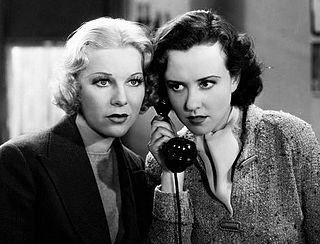Top Qs
Timeline
Chat
Perspective
Margaret Lindsay
American actress (1910–1981) From Wikipedia, the free encyclopedia
Remove ads
Margaret Lindsay (born Margaret Kies; September 19, 1910 – May 9, 1981) was an American film actress. Her time as a Warner Bros. contract player during the 1930s was particularly productive. She was noted for her supporting work in successful films of the 1930s and 1940s such as Baby Face, Jezebel (1938) and Scarlet Street (1945) and her leading roles in lower-budgeted B movie films such as the Ellery Queen series at Columbia in the early 1940s. Critics regard her portrayal of Nathaniel Hawthorne's Hepzibah Pyncheon in the 1940 film The House of the Seven Gables as Lindsay's standout career role.
Remove ads
Early life
Margaret Kies (pronounced "keys") was born in Dubuque, Iowa, the eldest of six children of a pharmacist father who died in 1930. According to Tom Longden of the Des Moines Register, "Peg" was "a tomboy who liked to climb pear trees" and was a "roller-skating fiend". She graduated in 1930 from Visitation Academy in Dubuque.[3] Her 1945 resumé lists her academic credentials as National Park Seminary in Washington, D. C. and the American Academy of Dramatic Art (where one of her classmates was Robert Cummings).[4]
Remove ads
Career
Summarize
Perspective
1930s
She began her theatrical career on stage in two hit plays, Death Takes a Holiday and By Candlelight. Her friend Bob Cummings couldn't find work in pictures because casting directors were looking for English juveniles. Cummings then posed as the Englishman "Blade Stanhope Conway" and, as columnist S. R. Mook reported in 1936, "got more work than he could take care of. It was also Bob who, meeting Margaret Lindsay who had been in his class at the dramatic school, suggested to her (when she told him she couldn't find work) that she follow his example. She did."[5] Margaret Kies became "British actress" Margaret Lindsay.
She impressed Universal Studios enough to sign her for their 1932 version of The Old Dark House. As James Robert Parish and William T. Leonard wrote in Hollywood Players: The Thirties (Arlington House, 1976), Lindsay returned to America and arrived in Hollywood, only to discover that Gloria Stuart had been cast in her role in the film. After some minor roles in pre-Code films such as Christopher Strong and the groundbreaking Baby Face, which starred Barbara Stanwyck, Lindsay was cast in the Fox Film Corporation's award-winning Cavalcade. Lindsay was selected for a role as Edith Harris, a doomed English bride whose honeymoon takes place on the Titanic.

Lindsay signed a five-year contract with Warner Bros., playing leads in both major and minor features, including G Men (1935) opposite James Cagney and Garden of the Moon (1938) opposite Pat O'Brien. Lindsay co-starred with Bette Davis in four Warners films: as Davis's sister in Fog Over Frisco (1934); in Dangerous (1935), for which Davis won her first Best Actress Academy Award; in Bordertown with Paul Muni, and as Davis's rival for Henry Fonda's affections in Jezebel (1938).


After her tenure at Warners, she went to Universal where her old friend Bob Cummings had the juvenile lead in adolescent singing star Gloria Jean's first picture, The Under-Pup (1939). Cummings reunited with Lindsay, who played a supporting role.
1940s
Michael Brunas, John Brunas, and Tom Weaver wrote in Universal Horrors: The Studio's Classic Films, 1931–46 that Lindsay, "one of the more talented '30s leading ladies, contributes a mature performance that might be the best, certainly the most striking in [The House of the Seven Gables]."[6]

Her 1940s film work in Hollywood included Columbia Pictures's first entry in their Crime Doctor series, as well as her continuing role as Nikki Porter in Columbia's Ellery Queen series (1940–1942).[7]
Lindsay appeared in a supporting role in the 1942 film The Spoilers. After Universal Pictures released her from her contract, she returned to the stage, appearing on Broadway in Another Love Story, which had a three-month run at the end of 1943.[8] Disappointed, she went back to Hollywood, but her film career went into temporary decline, with roles mostly in films at low-budget studios like Monogram Pictures and PRC.[9][10] She returned to bigger film work in 1947, featured in MGM films like Cass Timberlane with Spencer Tracy and Lana Turner.[11] She again returned to the stage and co-starred with Franchot Tone in The Second Man.[12]
1950s and 1960s
She made her television debut in 1950 in The Importance of Being Earnest,[13] which allowed her to display her finely honed British accent. More television work followed. Lindsay appeared in only four films during the 1950s and two in the 1960s. Her final feature film was Tammy and the Doctor (1963).
Remove ads
Personal life
Early in her career, Lindsay lived with her sister Helen in Hollywood, Los Angeles. Later in life, she lived with her youngest sister Mickie. She never married.
According to biographer and historian William J. Mann, Lindsay was the life partner of actor Mary McCarty.[14][15] Her dating companions included other reportedly gay stars like Cesar Romero, Richard Deacon, and Liberace.[16][17] She was also linked romantically to Janet Gaynor.[18][19][20]
Death
Lindsay died at the age of 70 of emphysema in 1981 at the Good Samaritan Hospital in Los Angeles.[21] She was buried at Holy Cross Cemetery, Culver City, California.[22]
Family
Lindsay's sister, Jane Kies, was also an actress under the stage name Jane Gilbert.[23]
Complete filmography
Remove ads
References
Further reading
External links
Wikiwand - on
Seamless Wikipedia browsing. On steroids.
Remove ads

